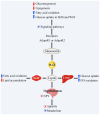Adipokines, Myokines, and Hepatokines: Crosstalk and Metabolic Repercussions
- PMID: 33807959
- PMCID: PMC7961600
- DOI: 10.3390/ijms22052639
Adipokines, Myokines, and Hepatokines: Crosstalk and Metabolic Repercussions
Abstract
Adipose, skeletal, and hepatic muscle tissues are the main endocrine organs that produce adipokines, myokines, and hepatokines. These biomarkers can be harmful or beneficial to an organism and still perform crosstalk, acting through the endocrine, paracrine, and autocrine pathways. This study aims to review the crosstalk between adipokines, myokines, and hepatokines. Far beyond understanding the actions of each biomarker alone, it is important to underline that these cytokines act together in the body, resulting in a complex network of actions in different tissues, which may have beneficial or non-beneficial effects on the genesis of various physiological disorders and their respective outcomes, such as type 2 diabetes mellitus (DM2), obesity, metabolic syndrome, and cardiovascular diseases (CVD). Overweight individuals secrete more pro-inflammatory adipokines than those of a healthy weight, leading to an impaired immune response and greater susceptibility to inflammatory and infectious diseases. Myostatin is elevated in pro-inflammatory environments, sharing space with pro-inflammatory organokines, such as tumor necrosis factor-alpha (TNF-α), interleukin-1 (IL-1), resistin, and chemerin. Fibroblast growth factor FGF21 acts as a beta-oxidation regulator and decreases lipogenesis in the liver. The crosstalk mentioned above can interfere with homeostatic disorders and can play a role as a potential therapeutic target that can assist in the methods of diagnosing metabolic syndrome and CVD.
Keywords: adipokines; cardiovascular diseases; hepatokines; metabolism; myokines.
Conflict of interest statement
The authors declare no conflict of interest.
Figures




References
-
- Sofra X., Badami S.J.H. Adverse effects of sedentary lifestyles: Inflammation, and high-glucose induced oxidative stress—A double blind randomized clinical trial on diabetic and prediabetic patients. Health. 2020;12:1029. doi: 10.4236/health.2020.128076. - DOI
-
- Sandhu R., Chandora C.J.T.U. Cure of obesity in homeopathy: An approach to control a global epidemic. Tantian Univ. J. Homoeopath. Med. Sci. 2020;1:17–22.
-
- Bergamini M., Iora P.H., Rocha T.A.H., Tchuisseu Y.P., Dutra A.C., Scheidt J., Nihei O.K., de Barros Carvalho M.D., Staton C.A., Vissoci J.R.N., et al. Mapping risk of ischemic heart disease using machine learning in a Brazilian state. PLoS ONE. 2020;15:e0243558. doi: 10.1371/journal.pone.0243558. - DOI - PMC - PubMed
Publication types
MeSH terms
Substances
LinkOut - more resources
Full Text Sources
Other Literature Sources
Medical

